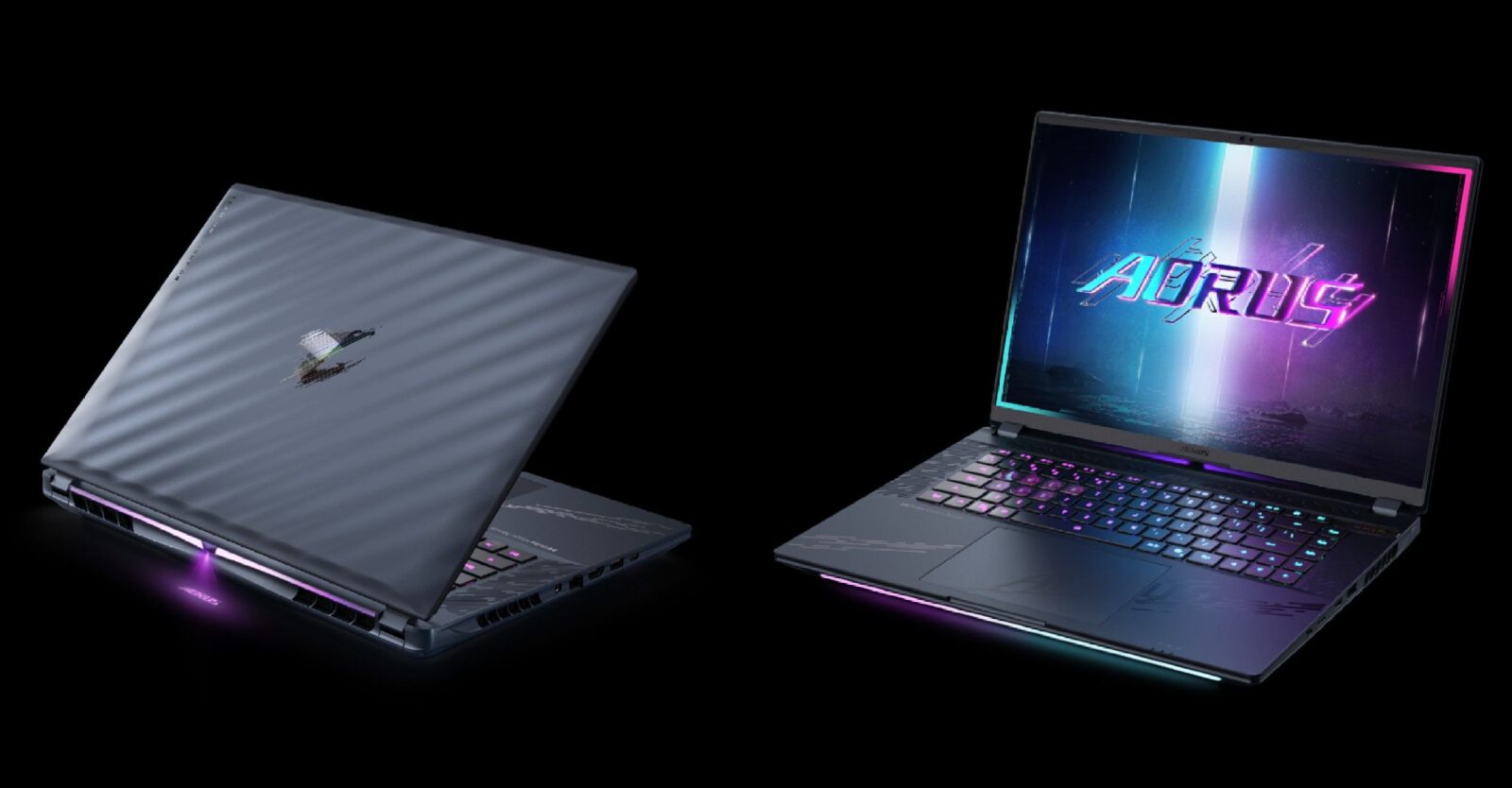The advent of the Nvidia 50 Series GPUs served to signal that a new generation of pre-built gaming PCs and laptops would shortly arrive, and the Gigabyte Aorus Master gaming laptops are some of the earliest high-end machines to boast Nvidia RTX 5080 and 5090 cards across their product line. Gaming laptops have come a long way since the earliest machines specifically built for that purpose, and the Aorus Master 16 ticks many boxes for anyone looking for a middle ground between a high-end gaming PC and a portable option like a Steam Deck or ASUS ROG Ally. But while the Aorus Master is capable of handling just about anything you can throw at it, there are a few small caveats to be aware of regarding its overall battery life and cooling, especially when factoring in the unit’s asking price.
For this review, we’ll be looking at the Gigabyte Aorus Master 16. The Aorus Master line of gaming laptops is split between the Aorus Master 16 and Aorus Master 18 (denoting the size of the units’ screens), and then further divided by the series of Nvidia GPUs each model contains. Our review of the Aorus Master 16 is specifically for model number BYH C5USE64SH, which comes packed with an Nvidia RTX 5080 (with a total of 175W TGP), an Intel Core Ultra 9 275HX CPU, 32GB of RAM, and a 1TB SSD. This unit is the Aorus Master 16’s mid-range option, sitting between the model that includes an RTX 5090 and a soon-to-be-released lower-end model with an RTX 5070 Ti. There are a small handful of nitpicks to be aware of with the Aorus Master 16, considering the unit’s MSRP of $3,099.99 (or $4,299.99 for the RTX 5090 model), but its sleek appearance and rock-solid performance position the laptop as an ideal, and more portable, alternative to a high-end gaming desktop.
The Aorus Master 16’s Appearance and OLED Display Are Sights to Behold
From the moment you get the Aorus Master 16 out of the box, it’s immediately apparent that it’s a sleek-looking machine with a lot of care and attention paid to its chassis’ design. When the unit is closed, the 12-layer nano-imprint lithography lamination (NIL) gives the lid a unique wavy appearance that helps it stand out from other gaming laptops, and the embossed Aorus logo is a subtle and classy design choice that does a good job of showcasing the unit’s RGB when powered on. While the chassis itself is plastic, it is by no means flimsy or weak, with the Aorus Master 16 feeling quite sturdy while somehow also managing to be relatively lightweight. It would have been nice to see Gigabyte use an all-metal chassis for a laptop at this price point, but this would have resulted in the unit likely being a bit more expensive, like the all-metal Razer Blade 16, as well as being substantially heavier.
When opened, the Aorus Master 16 continues to impress with its design, which foregoes any excessive RGB lighting or an overabundance of logos around the keyboard and touchpad. The keyboard itself is all black except for the gaming-heavy AWSD and QER keys, which Gigabyte has opted to make clear, helping to show off the unit’s RGB lighting. There’s also a subtle RGB strip on the front of the unit just under the touchpad that is practically unnoticeable when the laptop is in use, but adds some nice visual flair when sitting just a few inches away. The Aorus name is also etched along both the touchpad and the chassis — both without and with texture, respectively — and the touchpad itself is large and responsive. Together, both the keyboard and touchpad on the Aorus Master 16 sell the unit as being viable for a lot more than just gaming, even if that is its main purpose.
But the real star of the Aorus Master 16 is its QHD OLED display, which looks phenomenal in action. This 16-inch screen boasts ultra-thin bezels and a 240Hz refresh rate, which is great for games in which higher frame rates and more consistent performance are key. It’s also worth noting that the Aorus Master 16’s screen features an impressive 1ms response time, 1,000,000:1 contrast ratio, and HDR 500 support. Gigabyte has pulled out all the stops when it comes to the Aorus Master 16’s display, and it’s capable of rendering the most demanding games in stunning visual fidelity while also providing an eye-catching visual experience for productivity or entertainment.
The Aorus Master 16 Features Substantial Cooling, But at a Cost
It’s worth noting, though, that all the power the Aorus Master 16 delivers comes at the cost of the unit needing substantial cooling. Thankfully, Gigabyte has provided Aorus Master series laptops with its proprietary “Windforce Infinity” cooling system to help keep the units maintaining reasonable temperatures even during longer stretches of use. The one downside to these fans is that, while they are effective at keeping rising CPU temps at bay, they get incredibly loud, especially when playing on power versus on battery. The Aorus Master is capable of running brand-new games at max settings and easily achieving 120FPS or higher while keeping CPU and GPU temps reasonable, but doing so causes the unit’s fans to spin up so much that they give off the impression of a jet engine.
Even with the substantial cooling keeping the internals in check, it’s also worth noting that the Aorus Master 16 does get a little warm when running high-end games on its battery, with even the keyboard deck starting to warm up and some hot air noticeably coming out of the slotted vents just below the laptop’s display. The bottom of the unit also tends to warm up a good bit when playing off battery instead of power, but there’s a strong chance that most won’t actually use the unit as a literal laptop and instead play it at a desk or table anyway, especially considering the unit’s somewhat limited battery life.
Thankfully, the Aorus Master 16’s built-in four-speaker sound system provides a decent amount of “oomph” to the unit’s volume for times when you need to drown out the noise of the fans. Further, the inclusion of Dolby Atmos and the speakers’ dual-force design allows for the Aorus Master 16 to generate high-quality, distortion-free sound even at max volume, transforming the act of watching YouTube videos or movies into something that sounds just as good as it looks on the Master 16’s QHD OLED screen.
Putting the Gigabyte Aorus Master 16 Through Its Paces
The Gigabyte Aorus Master 16 is a great laptop for plenty of productivity-related and non-gaming functions, but any gaming laptop worth its weight (which, in the case of the Aorus Master 16, is a whopping 5.5 lbs) needs to have some demanding games thrown at it to truly determine what it’s capable of. The RTX 5080 mobile is a substantially more powerful card than even the desktop 5070 Ti, with an estimated 17% performance increase, which should ideally amount to the Aorus Master 16 being capable of running most modern games at max settings and maintaining stable framerates. Fittingly, the Aorus Master 16 can offer some eye-watering performance in the right situations, especially if you’re willing to utilize DLSS frame generation.
For the most part, the Aorus Master 16 was capable of pushing well past 60 FPS on even the most demanding games while playing at max settings with ray tracing enabled and DLSS on. Taking the unit off of power and having it run on battery resulted in some significant dips in performance, but it only struggled with one game in particular: Cyberpunk 2077. With the Ray Tracing: Ultra preset active, the Aorus Master 16 was only able to reach an average 30 FPS, even with DLSS turned on. And while both Cyberpunk 2077 and STALKER 2 performed well while the unit was plugged in via the AC adapter, running these titles on battery also seemed to drive up the CPU temps to surprising levels. In the case of STALKER 2, the CPU reached 97 degrees Celsius while traversing through the Zone.
To fully test out the capabilities of the Aorus Master 16, we used Black Myth: Wukong, Cyberpunk 2077, STALKER 2, and The First Berserker: Khazan, with each title running at maximum settings. To see how the unit would handle under certain power thresholds and performance loads on the CPU, we toggled between running the Aorus Master 16 on both the battery and its AC power, as well as toggling DLSS on or off to see how frame generation impacted performance, which provided the following results:
Steel Nomad benchmark score: 4,523
Black Myth: Wukong (Cinematic Settings, Ray Tracing at Max)
- On Battery (DLSS off): 19 FPS
- On Battery (DLSS on): 30 FPS
- On Power (DLSS off): 48-55 FPS
- On Power (DLSS on): 78-84 FPS
Cyberpunk 2077 (Outdoors, Ray Tracing: Ultra Settings)
- On Battery (DLSS off): 10 FPS
- On Battery (DLSS on): 24-30 FPS
- On Power (DLSS off): 25-30 FPS
- On Power (DLSS on): 40 FPS
The First Berserker: Khazan (Max Settings)
- On Battery (DLSS off): 45-50 FPS
- On Battery (DLSS on): 68-74 FPS
- On Power (DLSS off): 72-90 FPS
- On Power (DLSS on): 120 FPS
STALKER 2 (Open-world Zone exploration, Epic Settings)
- On Battery (DLSS off): 45-50 FPS
- On Battery (DLSS on): 55-60 FPS
- On Power (DLSS off): 135-153 FPS
- On Power (DLSS on): 138-194 FPS
In terms of performance, the Aorus Master 16 shines while it is plugged in and drawing from AC power, as well as when DLSS is enabled. Under these conditions, even the most demanding games are pushing past 60 FPS (with the very demanding Cyberpunk 2077 the sole exception). However, part of the point of owning a high-end gaming laptop versus a comparable desktop is the device’s portability, and the Aorus Master 16 suffers a noticeable decline in performance when running strictly off the battery. It doesn’t help that, in most circumstances, per our testing, the battery typically only lasts upwards of an hour before needing a charge.
To monitor performance in-game, we relied primarily on MSI Afterburner to track statistics related to both CPU and GPU performance while also monitoring CPU temperature and framerate. It’s worth noting, though, that the Gigabyte Aorus Master line of laptops comes pre-installed with Gigabyte’s proprietary GiMate monitoring software, which produces mostly the same results as Afterburner. One of the more surprising measurements from running more demanding games was how hot the Aorus Master 16’s CPU got, reaching ever closer to 100 degrees Celsius as the unit’s fans struggled to keep up, even when plugged into power. The Aorus Master 16 will automatically adjust the fan speed to Performance Mode as soon as you boot up a game, and adjusting this to the Silent Mode setting also resulted in a significant decline in performance to prevent the internal components from overheating.
Our Verdict on the Gigabyte Aorus Master 16
In addition to its impressive performance as a dedicated gaming laptop, the Aorus Master 16 is a sleek and stylish machine that works great for both regular web browsing as well as more productivity-focused tasks such as video or photo editing. The main caveat is the device’s battery life, which is fairly middling when compared to other gaming laptops at similar price points. But considering that the device is aimed towards gaming, and also that the Aorus Master 16 performs better when drawing from power instead of the battery, chances are that the drawbacks to the unit’s battery life won’t matter as much to anyone hoping to pick up a more portable, but still powerful, gaming PC.
Perhaps the bigger concern is the unit’s need for substantial cooling, along with its larger chassis to house the Aorus Master 16’s high-end internals, which ultimately affect the device’s viability as a portable unit even more than the battery life. A charger or outlet might always be within reach, but the noise that the Aorus Master 16 generates might not be ideal for longer play sessions, depending on where you happen to be. The Aorus Master 16 has a steep asking price for both the 5080 and 5090 models, but if you can look past the units’ disappointing battery life and substantial noise during demanding games, it’s a gaming laptop whose performance and sleek appearance mostly justifies its MSRP.
The Gigabyte Aorus Master 16 is currently available for pre-order, starting at $3,099.99.











Leave a Reply